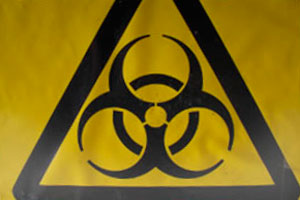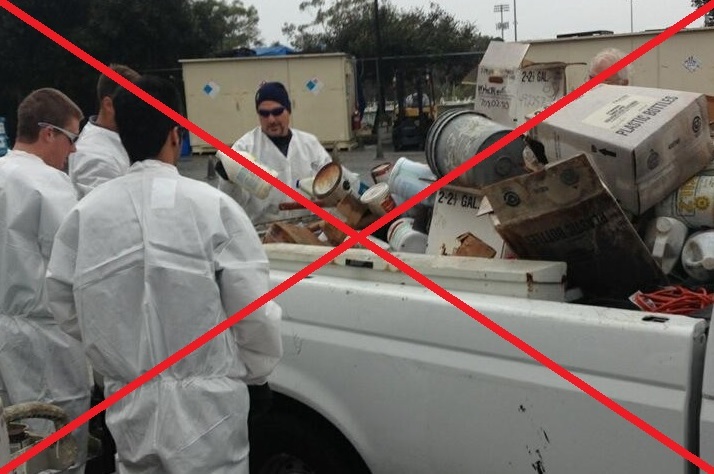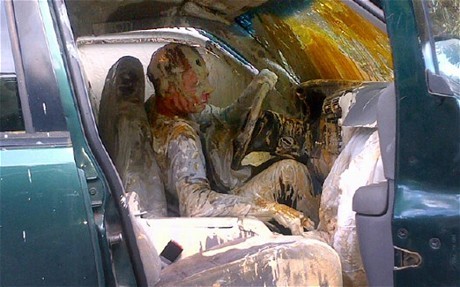
Hazardous Waste Warning
<![endif]--> Wastes in this section are dangerous to you and the environment. Handle them carefully and dispose of them properly. Legally, households may not transport more than 15 gallons of wet or 125 pounds of dry hazardous materials. Read about the regulation.
Click below to watch our hazardous waste video:
What are Hazardous Wastes?
Hazardous Wastes are materials that are either flammable, corrosive, highly reactive or poisonous. As such, they should not be put in the trash. Many chemicals used around the home, in our cars, and in manufacturing are hazardous. Expand the list below for specific examples and links to more information.
-
Batteries
-
Painting Products
-
Automotive Fluids
- Motor Oil and Oil Filters
- Antifreeze
- Other Automotive Fluids (gasoline, diesel, transmission, brake and steering fluids)
-
Fluorescent Lights and Mercury
-
Asbestos
-
Sharps and Pharmaceutical Waste
- Syringes (needles), Lancets and other Sharps
- Household Medications
-
Cleaning Products
-
Pool and Hobby Supplies
-
Gardening and Farm Supplies
- Pesticides, Herbicides, and Fertilizers
-
Other Hazardous Waste
Electronics also pose a hazard when not disposed of properly. E-waste should never go into the trash or recycling and must be disposed of at specific e-waste collection facilities. Visit our E-waste page for all the details.
Where can I bring my hazardous waste?
Not all hazardous waste facilities are the same. Some are free to only residents of certain areas, some accept different materials, and most have different hours of operation.
All local hazardous waste collection centers are listed in the “Where to Go” section at the bottom of each material page, but we’ve also included them here (click a specific region to expand the list):
-
Carpinteria
-
Santa Barbara/Goleta
-
Santa Ynez Valley
-
Lompoc/Vandenberg Air Force Base
-
Santa Maria Valley
Who can use hazardous waste collection facilities and events?
Hazardous Waste facilities and one-day collection events are designed for residents and small businesses. Businesses should review our Businesses with Hazardous Waste page for more details.
Each event and facility is different, so please review the information carefully. Contact the event or facility operator if you have questions.
Do not bring explosives, biohazards, radioactive materials, needles, or controlled substances to hazardous waste collection sites or events unless specified.
How should I transport my material?
Please make sure that all of your waste is securely contained in your vehicle. Each container should have a properly fitting lid and must be no larger than 5 gallons. Also, it’s best to double-contain your material in cardboard boxes or plastic bins.
Each collection center has its own acceptance limits, so please call ahead to see how much waste you can transport at one time. Residents should never carry more than 15 gallons or 125 pounds of hazardous waste in their vehicle at a time. Customers that are carrying more than what can be accepted at a specific location may be turned away.

This is a great example of what NOT to do. Transporting waste unsecured and in improper containers puts both yourself and the community at risk.

Photo courtesy of AP Photo/Washington State Patrol, Russ Winger
What if I have too much hazardous waste to transport and need it picked up?
If you have a large amount of hazardous waste and need onsite collection service, please visit our Hazardous Waste Haulers page or download the list of haulers here.
Where are the County-run Hazardous Waste Centers?
A complete list of County-run facilities, including the Community Hazardous Waste Collection Center, can be found on our County Facilities Page. Also check out our latest Hazardous Waste Program Annual Report.
Complete List of Pages in Hazardous Waste
Every page in the Hazardous Waste section is listed below. Either look through it to find what you are looking for or use the search bar.
- Aerosol Cans (with contents)
- Agricultural Oil
- Antifreeze
- Asbestos
- Asbestos Removal Services & Testing
- Audio Visual Equipment Reuse
- Audio-Visual Equipment Recycling
- Automotive Batteries
- Automotive Fluids
- Ballasts
- Batteries Explained
- Biohazard Waste
- Broken Fluorescent Light Clean-Up
- Business Electronics Recycling
- Business Electronics Reuse
- Business Hazardous Waste
- Cell Phones/Smart Phones Recycling
- Cell Phones/Smart Phones Reuse
- CFLs – Compact Fluorescent Lights
- Cleaning Products
- Compressed Gas
- Computers & Peripherals Recycling
- Computers & Peripherals Reuse
- Cuyama Valley Collection Event
- DVD and CD Recycling
- DVD and CD Reuse
- E-Bike Batteries
- Electronic Cigarettes
- Electronics FAQs
- Electronics Regulation
- Electronics Repair
- Electronics Reuse
- Electronics Take Back Programs
- Emergency Flares
- Fire Extinguishers
- Fluorescent Light Tubes
- Hazardous Waste Haulers
- Hazardous Waste Regulation
- Holiday Lights Recycling
- Holiday Lights Reuse
- Laptop Computers Recycling
- Laptop Computers Reuse
- Large Appliances Recycling
- Large Appliances Reuse
- Latex-Based Paint
- Lead Paint Disposal
- Lead Paint Removal
- Lead Paint Testing
- LED Lights
- Medications
- Mercury Containing Devices
- Mold Removal
- Mold Testing
- Motor Oil
- Motor Oil Filters
- Non-Rechargeable Batteries
- Office Equipment Recycling
- Office Equipment Reuse
- Oil-Based Paint
- Pesticides, Herbicides and Fertilizers
- Photochemicals
- Pool Supplies
- Portable Electronics Recycling
- Portable Electronics Reuse
- Printer Cartridges
- Propane Tank Recycling
- Rechargeable Batteries
- Reduce Electronic Waste
- Santa Ynez Valley Collection Event
- Sharps
- Small Appliances Recycling
- Small Appliances Reuse
- Smoke Detectors
- Solar Panels
- Solvents and Adhesives
- Stains and Finishes
- Tapes (Audio and Video)
- Telephone Recycling
- Telephone Reuse
- Toxic Waste
- Treated Wood
- TV & Computer Monitors Reuse
- TVs and Computer Monitors Recycling
- Vacuums Recycling
- Vacuums Reuse
- Video Game Recycling
- Video Game Reuse
- Vinyl Records Recycling
- Vinyl Records Reuse
Related Events
-
Solar Panel Reuse and Recycling Event
November 14, 2025 -
City of Santa Barbara Marine Flare Collection Event
November 16, 2025 -
Buellton Hazardous Waste Collection Event – November
November 1, 2025 -
Cuyama Valley Household Hazardous Waste Event
October 4, 2025 -
Santa Ynez Valley Household Hazardous Waste Event
October 5, 2025 -
Buellton Hazardous Waste Collection Event – August
August 2, 2025 -
Buellton Hazardous Waste Collection Event – May
May 3, 2025 -
City of Santa Barbara – Household Hazardous Waste Event
November 16, 2024 -
Cuyama Valley Hazardous Waste Collection Event
October 5, 2024 -
Buellton Hazardous Waste Collection Event
May 4, 2024
Related Articles
-
New Annual Report Available for County’s Hazardous Waste Collection Programs
October 15, 2024 by Owen Walsh - Hazardous Waste Recycling/Disposal -
Community Hazardous Waste Collection Center Tour Offered During Creek Week!
August 26, 2024 by Kaitlyn Haberlin - Hazardous Waste Recycling/Disposal -
FREE Household Hazardous Waste Event!
March 31, 2024 by Kaitlyn Haberlin - Hazardous Waste Recycling/Disposal -
Latest Annual Report Available for County’s Hazardous Waste Collection Program
January 10, 2024 by Tori Kampmann - Hazardous Waste Recycling/Disposal -
Thanksgiving Facility Closures
November 22, 2023 by Tori Kampmann - Hazardous Waste Recycling/Disposal -
Did you know that used motor oil and oil filters are recyclable?
May 24, 2023 by Kaitlyn Haberlin - Hazardous Waste Recycling/Disposal -
Be Aware of Proper Battery Disposal this Holiday Season
December 12, 2022 by Kaitlyn Haberlin - Hazardous Waste Recycling/Disposal -
NEW Online Appointment Request System for Small Businesses Using the Community Hazardous Waste Collection Center
July 01, 2022 by Tori Kampmann - Hazardous Waste Recycling/Disposal -
Olympic Medals Made from E-Waste!
August 11, 2021 by Kaitlyn Haberlin - Electronics -
Hazardous Waste Disposal Options in Santa Barbara County
June 04, 2021 by Tori Kampmann - Hazardous Waste Recycling/Disposal